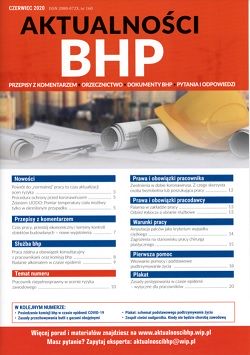
- News
- Return to "normal" work is the time to update risk assessments (3)
When organizing the return of employees to stationary work, it is crucial to determine the risk factors at specific workplaces related to the possibility of COVID-19 spreading. Employees of the OSH service should also correct the risk assessment and include in it all potential new threats, but not only for physical health. Particular attention should be paid to the mental state of the employee.
- Coronavirus protection procedure (5)
When specifying the procedure to be followed in the event of a coronavirus threat, the recommendations of the National Labor Inspectorate and the National Sanitary Inspection for employers should be used. At the beginning you should describe what a virus is and what are its effects on the respiratory system and circulation. Proper preventive measures should also be indicated. The article presents a ready procedure for protecting employees in the workplace.
- Recipes with commentary
- Working time, economic downtime and deadlines for building inspection - new explanations (7)
Check how long you can use solutions from the COVID-19 Act related to working time. See also how to count the remuneration of contractors on the so-called economic downtime. What to do in a situation where the deadline for checking electrical installations and buildings expired during the epidemic. Find out the answers of the ministries of work and development to the questions of our readers.
- OSH service
- Remote work and consultation obligation with employees and the OHS commission (8)
Ensuring the right level of work safety is the basic responsibility of every employer. However, decisions regarding actions taken in the field of OSH are not a private matter of the employer. His duty is to consult with employees or their representative all activities related to occupational health and safety. Recently, remote work performed to counteract COVID-19 should be a special subject of consultation.
- Breathalyzer test during an epidemic (9)
The use of breathalyzers with replaceable disposable mouthpieces significantly reduces the possibility of workers being exposed to COVID-19 than breathalyzers not equipped with such mouthpieces. But can an employer check the sobriety of an employee?
- Subject of the issue
- Disabled worker in occupational risk assessment (10)
We present the assessment of occupational hazards and risks at the workplace of a disabled worker (with paresis of the lower limbs, moving in a wheelchair), employed to operate a screen monitor. The assessment of occupational hazards and risk was performed using the PHA method.
- Work and duties of an employee
- Release on the day of the coronavirus. What will benefit the unemployed or jobseeker (12)
The new regulation on registration of the unemployed and jobseekers has introduced many facilitations for those interested. The regulations provide for a special procedure for the "pre-registration" of an unemployed or jobseeker during a coronavirus epidemic. Check what services and labor market instruments are available to people who have recently lost their jobs.
- Smoking room in the workplace (13)
Issues related to smoking have been regulated in the Act on the protection of health against the consequences of using tobacco and tobacco products. In the light of the provisions of this Act, smoking is prohibited in the premises of the workplace. Can the employer organize a smoking room in this area? Or maybe he has such an obligation?
- Work clothes and uniforms (13)
Regardless of whether the employer provides employees with work clothes or the assortment of uniformed uniforms they have established, they must provide the opportunity to change clothes at work. But can the employer give administrative and office employees (work at the reception desk) work clothes, e.g. in the form of white blouses and navy blue skirts and orders to use them at work? Are there differences between workwear and work clothes?
- Working conditions
- Finger amputation as a criterion for a serious accident (14)
Does trauma to the crushing of the foot and long-term hospital stay (about 2 months) ended with amputation of the toes of the I-III tables for the proximal phalanges meets the criteria of a serious accident?
- Threats at the workplace of the plastic surgeon (15)
The plastic surgeon is exposed to many dangerous, harmful and arduous factors in his work. When preparing for an employee's health and safety training, you must first identify the most common hazards at this workplace so that you can apply appropriate protection against them. Employees should be informed about the risks and protection measures during the first phase of training. This is fundamental information that will help reduce the number of accidents at work.
Aktualności BHP (OSH News) - the whole list







